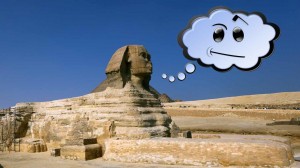 Just before the holidays—near the end of the semester, by the academic calendar—us editors here at Overthinking It were surprised when we started getting cryptic and unsolicited article submissions about pop culture references to the culture and religion of ancient Egypt. One was odd, but reasonable. Two was a sign something was up. By the time we go to three, four, five—well, it seemed like an ancient curse might be involved.
Just before the holidays—near the end of the semester, by the academic calendar—us editors here at Overthinking It were surprised when we started getting cryptic and unsolicited article submissions about pop culture references to the culture and religion of ancient Egypt. One was odd, but reasonable. Two was a sign something was up. By the time we go to three, four, five—well, it seemed like an ancient curse might be involved.
It turns out it was the next best thing to an ancient curse: a zealous college professor. An OTI reader and guest article contributor teaches a course for college freshmen called “Mystique of Ancient Egypt,” and for their final project, she assigned students an Overthinking It-style paper relating the material they had studied in the course to some aspect of contemporary culture, with extra credit if they submitted the papers to us as guest articles.
As editors we were a bit flummoxed. Some emails had a full article or the beginning of one attached, but some were single mysterious sentences devoid of context. What were we supposed to do with all of them?
Well, one night I came home late and decided to do the only thing I could do to emails like this — I answered them. The emails and my answers of a variety of snarkiness are below for your consideration.
From: Kate M********
“Power Behind the Curse of King Tut”
I am going to write my article on the power behind the curse of King Tut, which I believe it to be the culture of the Egyptian people. I think the important aspect of the curse is the culture of the afterlife as seen through the eyes of Egyptian people.
* * *
Hi Kate,
This is Fenzel from Overthinking It, responding to your idea!!
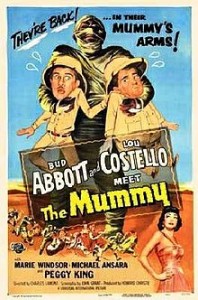
We are a light-hearted pop culture website, so the only context in which we’d be interested in something like this is if it considered the pop culture depiction of the curse of King Tut—like the boom in “curse of the mummy”-type movies in the 30s, 40s and 50s. I’d be especially interested in a discussion of Abbot and Costello Meet the Mummy, from 1955, and a joke about Steve Martin’s “King Tut” song would pretty much be obligatory.
I’m curious what you mean by the “power” being “the culture of the Egyptian people” (certainly the “Egyptian People” are not one homogenous group of folks who, immortal and unmoving, have done the same stuff in the same place forever). “Power” and “people” can mean a lot of things. So can “culture” and “Egypt.” Feel free to elaborate.
If you wanted to talk about Ancient Egyptian ideas of the afterlife as they contrast to modern Western views of the Afterlife as a potential source of subtextual narrative tension in the Brendan Fraser and post-Brendan Fraser Mummy movies (and, to a lesser but similar extent, the Scorpion King super-sequels), then you’ve got my attention.
-Pete
Hello! I’m Devon F*******, and I’m a student at ************ University. I wrote an article and would like to pitch the idea.
The Harry Potter series, by J.K. Rowling, has many connections to ancient Egypt, especially concerning the character of Lord Voldemort. This character himself shares multiple similarities to the Egyptian God Apep. This god manifests as a giant snake and he is the god of evil. As a result, snakes are symbolic of evil in ancient Egyptian culture (Spence). The seven Horcruxes correspond with the seven parts of the Egyptian body and soul. A part of the myth of Apep is entirely mirrored in J.K. Rowling’s Harry Potter and the Chamber of Secrets. Apep is known to be able to inflict darkness upon the land, and so can the Dark Lord Voldemort. Apep was a threatening image to the ancient Egyptians, just as Voldemort is frightening to the world of witches and wizards in the Harry Potter series. J.K. Rowling must have made these connections to emphasize how the ancient Egyptians were a magical race and they had knowledge no one else did. This author trying to draw in readers from today’s society which is fascinated with the ancient Egyptians lives.
Please let me know what you think! Thank you for your time.
From, Devon F*******
* * *
Hi Devon,
This is Fenzel from Overthinking It, responding to your idea!!
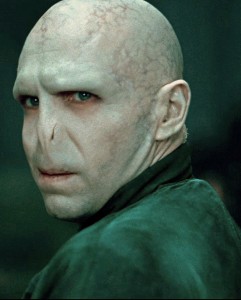
DON’T SAY THAT NAME!!!!!
Regards,
Pete
P.S. A lot of this is great! You actually have an idea for something here! I do have two problems with it though:
J.K. Rowling must have made these connections to emphasize how the ancient Egyptians were a magical race and they had knowledge no one else did.
This is probably like the opposite of a true, correct thing to say, in the sense that it is more the kind of thing you would say if you were, say, making a joke or a crazy person.
Perhaps you would have to ask her, but I do not think J.K. Rowling thinks any people actually have magical powers in real life.
What I think you probably mean is more along the lines of J.K. Rowling drawing on existing cultural tropes that identify Egypt as a magical place with secret, arcane knowledge, which can be found in many places in turn of the millenium English culture specifically and Anglo-American and European cultures in general.
This author trying to draw in readers from today’s society which is fascinated with the ancient Egyptians lives.
This is less egregious, and more the beginning of a thought—I do not think J.K. Rowling is merely thinking that, because Egypt is really popular, she will put Egyptian things in her books and her books will be more popular.
I think there are qualities to the cultural symbolism associated with ancient Egypt that people do like and identify with, and that these symbols are useful in telling a coming of age story – especially as they pertain to the ideas of secrets and revelations – especially secrets and revelations associated with previous generations, as seen from the perspective of adolescent children.
Perhaps the pasts of all our parents that predate us are something like a library search or an archaeological dig. Or perhaps there’s a particular way the Ancient Egyptians thought about death that corresponds with important steps young people can take in coping with their own ideas of death.
We shall see! Let ’er rip!
(Devon actually then actually took my notes seriously and wrote a full paper that was pretty good! He was the only person to respond to me in such a positive way, though I hardly deserved it. Sadly, it’s a bit too long to include here, but it was solid. So, go Devon! If you want to read Devon’s paper, email [email protected] and I’ll consider sending it to you. – PF)
From: Kayla L******
I have been writing a paper that compares Kim Kardashian and Cleopatra, and decided that I would try for a submission.
* * *
Hi Kayla,
Thanks! This is Fenzel from Overthinking It. I’ve been doing some stuff too! I went to a surprise party tonight for a friend of mine! And right now I am responding to some emails from college students.
I am tempted to say “go ahead and contact us when you have something ready, as I will similarly contact you when I have accomplished something relevant,” but I’ll tone down the glib a bit and offer a thought.
Are you comparing Kim to Cleopatra?
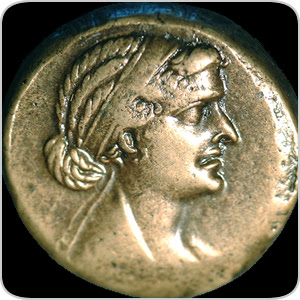
Cleopatra?
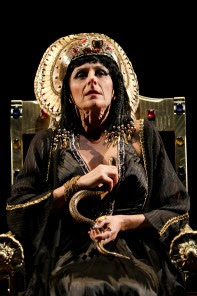
Cleopatra?
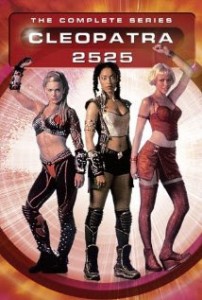
…or Cleopatra?
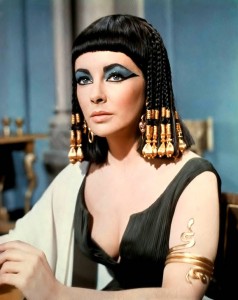
One of these to me seems more apt and interesting than the others.
Regards,
Pete
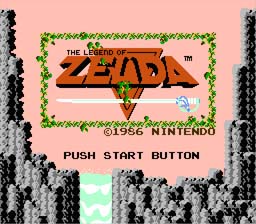 Greetings editors!
Greetings editors!
My name is Olivia L******* and I am a freshman at ********** University. I am currently taking a First Year Seminar on the Mystique of Ancient Egypt and for our final project we are to write as though we are writing for Overthinkingit. I would like for my article to make this website as I think it would be fitting. My paper is about the Legend of Zelda video games. In the games there are many symbols, characters and elements that resemble Egyptian culture. These aspects are used due to Egypt’s alluring mystique. Thank you for your time and consideration!
* * *
Hey Olivia,
Awesome! Show us what you’ve got when it’s ready.
Although I do sort of balk at the casual mention of “Egypt’s alluring mystique” as if it is this universal thing that exists without time or context. The Legend of Zelda didn’t spring, magic shield and white sword in hand, from the skull of a Gauntlet arcade machine. Specific people made it. What does Egypt’s “alluring mystique” mean for these people?
Just to toss an idea out there – the people who first made The Legend of Zelda and the people who crafted the artifacts we still have from Ancient Egypt had a few things in common – one of which, notably, being that the media they worked in was really restrictive. It is hard to carve things in stone, and it is hard to represent shapes in 8-bit sprites. I might consider thinking about the role of simple, iconic geometric shapes in Ancient Egyptian symbolism, and whether or how they are a natural fit for use in 8-bit video games.
Regards,
Pete
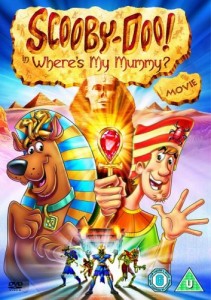 From: Shannon L*******
From: Shannon L*******
Is the movie “Scooby-Doo! in Where’s My Mummy” trying to say that there is a secret tomb underneath the Sphinx.
* * *
Hi Shannon,
This is Fenzel from Overthinking It, responding to your email!!
I don’t know. I haven’t seen it.
Your move.
Regards,
Pete
(I’m still waiting for that move of yours! -PF)
From: Christopher O******
I am a current college student taking a class on Ancient Egypt, for our final paper we have to come up with an over-thinking it idea. My idea is based off of the Magic Tree house series by Mary Pope Osborne, I have come to a conclusion that the structure of this series is based off of the path to the life after death in Ancient Egypt. Similarities include the magic tree house being the entrance to the hall of two truths, Jack and Annie’s adventure is equivalent to the hall of two truths, and also proving themselves worthy of passing into the fields of Aaru then waiting to be re-created by traveling back home in the tree house.
* * *
Hey Chris,
This is Fenzel from Overthinking It, responding to your email!!
Cool! I’m not familiar with this book series, but it seems like a good topic.
It would also be good to explain why this matters. It’s one thing to point out the similar symbols or when one story is based on another. It’s another thing to point out why anybody should care.
What does this add to the story? I’m sure you can figure some of that out.
Rock!
-Pete
From: Anna F*******
I was required to write an overthinkingit paper for my final in my ancient Egyptian class. I really liked the outcome of my paper so I decided to pitch the idea to you and see if I could get my paper published. My topic is comparing and contrasting the popular Alex and Ani bracelets (specifically the eye of Horus charm) with the “Power Balance” bracelets. In my paper I talk about how the mystique and magic of ancient Egypt helps to sell the Alex and Ani bracelets and will give their company an advantage over their “Power Balance” competitors.
* * *
Hey Anna,
This is Fenzel from Overthinking It, responding to your email!!
We’re still trying to figure out what to do with this huge influx of paper submissions, but this sounds like an interesting topic. I’m not familiar with these bracelets – does the paper explain what they are to the non-initiated?
I get a little squicky around this idea of the general Egyptian “mystique” being commercially desirable, and then just ending it at that. I hope there’s some other commentary about Egypt besides just pointing out that people think the Egyptian-looking bracelets are exotic and thus they will sell better.
But I’m curious!
Regards,
Pete
Good afternoon,
My name is Anthea A*******. I attend ********** University. Writing an article for your website was our final project in my Mystique of Ancient Egypt class. I wrote about how mummies in three examples of entertainment (Books: Lost in a Pyramid by Louisa May Alcott & The Unwrapping of a Mummy by Theophile Gautier and the movie Mummy Maniac) to distract viewers from the misogyny issues that exist amongst our society.
* * *
Hi Anthea,
This is Fenzel from Overthinking It, responding to your email!!
Let me see if I can figure this out.
I wrote about how mummies in three examples of entertainment (Books: Lost in a Pyramid by Louisa May Alcott & The Unwrapping of a Mummy by Theophile Gautier and the movie Mummy Maniac) to distract viewers from the misogyny issues that exist amongst our society.
Let me take out the parenthetical to maybe get a better sense for what you’re saying here.
I wrote about how mummies in three examples of entertainment to distract viewers from the misogyny issues that exist amongst our society.
Are you saying that you are trying to distract people who are watching you from considering issues of misogyny by writing articles about mummies? I don’t quite follow. I guess this might work, but I don’t know why you want people to be distracted from these important issues.
Maybe you mean that the mummies in these books are there to distract people from thinking about serious gender issues? That if the mummies weren’t in the books, people reading the books would confront misogyny in all its horror, but because the books have mummies in them, people are startled and entertained, and thus lose their energy for the struggle toward equal rights for women? This to me seems highly dubious.
Louisa May Alcott did not have a personal mission of covering up crimes against women, and her literature does not exist to distract people from important social problems.
What exactly are you trying to say here? I really don’t know, and would like some clarifications.
Regards,
Pete
From: Emily H*******
“Anubis in Pop Culture”
The Egyptian god Anubis is seen in many pieces of pop culture today in society. Anubis’s character is often not portrayed accurately. Anubis is the god of the dead; also know as “lord of the hallowed land” and “he who is before the divine booth” (Lurker 28). He takes the form of a jackal, which is a medium sized animal, related to the wolf species. Often times, he only takes the form of a jackal head and a human body. Anubis guarded mummies from evil forces during the nighttime. Because he was the guardian god, a black jackal was on many of the doors of rock tombs he watched over symbolizing safety and protection.
Anubis was the son of Nephthys and Osiris, who are actually brother and sister; but Nephthys tricked Osiris into having intercourse with her (Mercatante 11). However, Nephthys abandoned Anubis and he was brought in and raised by the goddess Isis.
One of Anubis’s important jobs was protecting the hearts of the deceased when the souls crossed into the other world from Amam, or “the devourer,” who ate the dead (Mercatante 12). The cult of Anubis also continued into Roman and Greek times, the name Anubis is actually a Greek rendering of Anpu, the Egyptian name of Anubis.
Prayers to Anubis are found carved on ancient tombs. He watches over mummification processes to ensure that everything is done correctly. He controls the souls in the underworld and tests their knowledge of the gods and their faith to the gods. He places their hearts on the Scales of Justice during the Judging of the Heart, and he feeds the souls of bad people to Ammit, a demon with the head of a crocodile.
In today’s pop culture, Anubis is seen in many television shows, movies, and even video games. Some of these include ABC’s television series “Lost,” the movie “The Mummy Returns,” Nickelodeon’s television series “House of Anubis,” and the video game “Sphinx and the Cursed Mummy”.
“The Mummy Returns” is a great example of Anubis used in pop culture. In “The Mummy Returns,” the Scorpion King vows to give his soul to Anubis for an army of jackal warriors for his plan of revenge for the death of his army. After the Anubis army destroys Egypt, Anubis takes the Scorpion’s soul and the army. After this, an Egyptian cult wishes to obtain Anubis’s army to take over the world. In the end, after fighting quite hard, the cult fails.
This representation of Anubis has its accurate pieces of information, but many of facts seem to be exaggerated in this film for entertainment purposes, to make it more interesting. An accurate piece of information used in the film is the fact that Anubis is in charge of souls in the underworld; therefore it does make sense that the Scorpion King gave the offering of his soul to Anubis. However, the army that the Scorpion King asks for in return for his soul does not seem realistic to his character. Although Anubis never had an army of warriors, it is understandable and somewhat more realistic that they were jackals.
Anubis mummified people, watched over the dead, and protected tombs. He was never known for making deals with people for their souls, or violent, vicious armies, or even having contact with people that were alive. He was not known for violence or evil, it was almost the complete opposite. He wanted peace for the dead.
There are good and bad aspects to this movie, in regards to the accuracy of the information about Anubis. It teaches people who Anubis is, and somewhat describes what he does. It is clear that he is the ruler of souls in the underworld, and that he works with the dead. It is also made clear that Anubis’s other form is a jackal, as jackals were very evident in the film.
The bad part about this film is that does not give very much accurate information. It is true that Anubis was seen in the form of a jackal, but he did not have an army of them. Anubis did not participate in any such activities like in this movie; he would not create something that would in turn destroy Egypt, such as this army. He also would not let a cult like the one in the movie get so close to taking over this deadly army and taking over the world with it.
Although it is a movie, and it is fiction, it is teaching people incorrect information. Some people could easily take this movie seriously, and believe that Anubis was not a protector, but someone who wanted to promote violence. It does not make it clear that Anubis is the guardian god, and that he protects the dead. Someone could easily interpret this film as Anubis being the opposite of what he actually was.
Films about ancient Egypt tend to exaggerate facts to make it more interesting. Mummies are not evil; they are deceased people that have been attempted to be preserved by the people of their time. Filmmakers associate mummies with evil, so when Anubis is described as the protector of mummies, it is assumed that Anubis is the protector of evil, therefore being evil himself. This could easily give viewers the wrong idea about who Anubis actually was.
* * *
Hi Emily,
This is Fenzel, from Overthinking It! I’ve been going through all these Egypt pitches, sending people notes! Sometimes I have been a little silly or snarky about it. I hope people are not too upset by it.
Here’s my main critique of your pitch as it stands.
Anubis is not real.
Mummies – in the sense of reanimated corpses of ancient Egyptians – are not real.
Nothing concerning either Anubis nor a reanimated Mummy monster, independent of the context of being in a story, is a “fact”—except that they are not real.
Therefore, it is a little awkward to be describing their “actual” intentions, or whether they are “actually” good or evil.
It is also tricky to ascribe “accuracy” to stories about them. Why is Anubis in a video game today “less accurate” than Anubis in an Egyptian myth 4,000 years ago? Anubis never actually existed and was always fiction.
This is not a rhetorical question – if you think it is important that depictions of ancient Egyptian mythology correspond more closely to the source material, that’s fine, but you have to explain why it matters.
I know in an intuitive sense that if I were describing a real person, saying false things about what that person said or did would be a problem or undesirable.
But a myth? Am I really wronging a myth by changing it?
Let’s take it past its logical extreme and ask, would Disney’s Hercules be a better or worse movie – or a better or worse thing to exist – if more of the movie was spent showing Zeus transforming into animals and having sex with human women? Would it be better if Hercules was shown killing his wife? To lower the stakes again, is Disney’s The Little Mermaid “inaccurate” because Ariel doesn’t die and turn to sea foam?
I get that it isn’t true to the source material, but this is the difference between “can” and “should.” You seem to be assuming these things “should not” be changed. I’m challenging you to say why this is so. Why should anyone care what is “true” about Anubis?
(If you put your mind to it, I think you can come up with some interesting answers to that question.)
Regards,
Pete
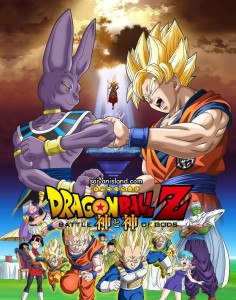 From: Patrick N*******
From: Patrick N*******
Dragon Ball Z: Destruction of Ancient Egypt
Now, I haven’t watched an episode of Dragon Ball Z in quite a while, but I recently came across a trailer for the recent movie “Dragon Ball Z: Battle of the gods.” Noticing that it was released in theaters (the first Dragon Ball Z movie in theaters in almost 20 years) I was curious as to what was so special about this movie. I did a little research about the plot, characters, etc.. and noticed something that sparked my interest. The god of destruction named Bills seems extremely similar to the ancient Egyptian goddess of destruction, Sekhmet. After further research and after watching the movie, I conclude that the plot of the movie was directly influenced by the ancient Egyptian story “The Destruction of Mankind”, meaning that modern day pop culture demonstrates the ancient Egyptians to be violent and destructive.
Before I continue I want to first state that I am currently taking a class on ancient Egypt in college, so it was actually quite refreshing to notice a comparison between these two as it seems that I am doing something right in class.
Dragon Ball Z is an anime television series that airs on Cartoon Network. This particular television channel is targeted mainly towards children or young teens because it only shows cartoons’. I’m not saying that only little kids watch Dragon Ball Z, but, a lot of little kids do. The plot of this show is to find the seven dragon balls in which then a magic dragon appears and can grant you any, one wish. But to do so, you must first find out where the dragon balls are and collect them, even if that means you must defeat someone. This show has a lot of cartoon violence and promotes violence throughout by showing the the hero Goku by always resort to fighting.
The ancient Egyptians have always been a interest to the modern era. They are most commonly known for the gold and riches that are hidden inside of a pyramid buried with a Pharaoh, or for hieroglyphics, they’re form of writing and reading. But what the children are learning about ancient Egypt by watching Dragon Ball Z is their violent background. There are obvious, and not so obvious, connections between Dragon Ball Z and ancient Egypt which exemplifies how pop culture views ancient Egypt and how they would like to portray it to their audience. If the writer of Dragon Ball Z did not want to compare the violence in his show with ancient Egyptian gods, why would he choose to base one of his shows’ gods after an Egyptian one? Like I mentioned earlier, many kids watch Dragon Ball Z and this may be the first information they ever receive on ancient Egypt. Though it is true that they were violent, I don’t believe that should be the first example to teach to children.
I would like to begin the comparisons starting with the most obvious, yet still important, traits between the two: the appearance. Ancient Egyptians have been known to draw humans with animal faces, or visa versa. Consider the Great Sphinx in Egypt for instance; a giant cat with a human face. Sekhmet is portrayed as a woman but with a lioness as a face. Bills, similarly, is portrayed as a cat. He is small and purple, but still a feline. Also, Bills is wearing jewelry that appears to be ancient Egyptian because can also be found on many images of Sekhmet. If Bills isn’t meant to represent Sekhmet then why would he be wearing ancient Egyptian attire? You don’t need to be an expert egyptologist to notice the similarities in appearance between the two deities, but every connection or comparison is useful.
Sekhmet can also be translated to “the mightiest” or “the powerful one”. Because of her power and strength, she is summoned by her father Re to destroy all of mankind. Unsurprisingly, Bills is also the most powerful god in his universe. Goku, the main character in Dragon Ball Z and who was also thought to be the most powerful character in Dragon Ball Z because he could reach super saiyan 3 (a very powerful form that most characters can’t reach) was defeated by Bills, twice.
Bills was first introduced in the Dragon Ball Z movie: Battle of the Gods as not only the most powerful god, but also the most feared. He is in charge of destroying other planets in order to balance out the universe and allow room for more planets to be created. He was awoken after years of sleeping by his trainer, Whis, to be told that his companion Frieza was defeated by Goku, therefore he could no longer destroy planets for Bills. Bills then takes matters into his own hands to defeat Goku and destroy planet Earth. Though Bills was more powerful than Goku, thus defeating him, he was too tired to destroy planet Earth. He attempted to blow up Earth, but could only build up enough energy to blow up a little chunk of the ground. He then went back to sleep for many years.
The plot of this movie seems oddly similar to the story “Destruction of Mankind”, where Sekhmet is awoken to destroy mankind. She (like Bills) is feared by everyone and can easily kill whoever she pleases. Re summons Sekhmet to destroy mankind because his people conspired against him. Instead of fighting back (like Goku) the people brew 7,000 jars of beer and make it look like blood for Sekhmet to drink. Sekhmet gets blackout drunk and passes out at the feet of her father.
So both Bills and Sekhmet were awoken from a deep slumber to destroy mankind, and both failed and went back to sleep. Now I’m not saying that the writer of Dragon Ball Z copied the story of the “Destruction of Mankind”, he merely took the basic plot, put his version in, and come out with a very similar conclusion. Whether they have the same plot or not, they are both very similar. All of the violence that Bills creates reminds us of the violence of Sekhmet and all of ancient Egypt.
* * *
Yay Patrick!!
This is Fenzel from Overthinking It – and if you know anything about the site, you know I am going to applaud your choice of general subject matter! I have not seen Battle of the Gods myself (it might be worth mentioning it was released only in Japan), but I have been following it a bit, so I’m somewhat familiar with it.
Now, that said, I think you have some work to do, even based on what little I know. Below I am going to list the sentences in what you typed below that I think are wrong, and I will try briefly to correct them where I have the energy:
The god of destruction named Bills seems extremely similar to the ancient Egyptian goddess of destruction, Sekhmet.
Bills is obviously modeled after Egyptian godhood. But Bills also obviously has a dark-colored head and big ears that stand up over his head. Even if you want to claim that Bills’s role in the story corresponds to Sekhmet, you really have to confront that Bills looks more like Seth or Anubis. I mean, that’s the obvious visual connection. Bills looks a bit like Anubis but acts like Sekhmet” is a pretty interesting place to start.
Dragon Ball Z is an anime television series that airs on Cartoon Network. This particular television channel is targeted mainly towards children or young teens because it only shows cartoons’.
This is simply incorrect. Cartoon Network also runs the “Adult Swim” block of programming targeted to adults and older youths, and has many adult viewers, both for Adult Swim and for its earlier programming. The Toonami block, which is part of Adult Swim, includes Dragon Ball Z is not targeted to children.
This show has a lot of cartoon violence and promotes violence throughout by showing the the hero Goku by always resort to fighting.
No offense, but I’m facepalming so hard at this that I’m threatening to drive my nose bridge into my brain. This is not Fist of the North Star we’re talking about here (in which driving my nose bridge into my brain would be highly appropriate).
Dragon Ball Z, and Dragon Ball before it, is from a Shonen manga that began as and remains structurally a farcical comedy. It is a parody of medieval Chinese literature, of adventure stories in general, of preceding martial arts manga, and, in its later material, very much a parody of itself. Goku does not “always resort to fighting.” Goku rarely kills his enemies, frequently looks for ways to forgive them or reconcile with them without violence or after violence, and sees training and fighting as avenues for self-improvement.
They are most commonly known for the gold and riches that are hidden inside of a pyramid buried with a Pharaoh…
Just to be accurate: I don’t think any modern archaeologist has ever found gold and riches hidden inside a pyramid (as they were all graverobbed long ago). The tombs in the Valley of the Kings that have been found with gold and riches in them were better hidden than that. But yeah, gold inside a pyramid is a cultural trope at this point. I just think you’re not really reflecting a great grasp of the history of Egyptology here.
There are obvious, and not so obvious, connections between Dragon Ball Z and ancient Egypt…
Wait, are we still talking about “Battle of the Gods”? Or are we talking about Dragon Ball Z in general? Dragon Ball Z probably has some other cultural relationships with Ancient Egypt – but Bills is only a character in the recent movie; it’s not like a major thing.
Also, if you study the Dragon Ball franchise (as you might, considering it is one of the most popular and successful entertainment franchises in history across many media) – the material is generally divided into “canon” and “non-canon,” based on the direct input and creative control of creator Akira Toriyama. The canon stuff has a lot of internal consistency and artistically interesting texture – the “non-canon” stuff is kind of sloppy and all over the place. This new movie has Toriyama more involved than usual, but he’s still not the main guy.
The point is, I don’t think you can make the jump that what is happening in “Battle of the Gods” is characteristic of Dragon Ball Z in general.
If the writer of Dragon Ball Z did not want to compare the violence in his show with ancient Egyptian gods, why would he choose to base one of his shows’ gods after an Egyptian one?
What? I don’t even know where you are going with this.
This seems to me less a question that ought to be offered rhetorically, and more a question you should answer yourself. The answer is not obvious.
Dragon Ball Z has a major villain in it who is a big fat rubbery ball of pink goo who turns people into chocolate and eats them while wearing a blanket as a cape around his neck and a pair of parachute pants. Is this saying chocolate is violent? Or pinkness? Or parachute pants?
“What do Dragon Ball Z villains represent?” is a huge topic. It’s not something you can just write off like this.
They do not just represent violence. Especially since most of the characters introduced as major bad guys eventually become good guys.
Like I mentioned earlier, many kids watch Dragon Ball Z and this may be the first information they ever receive on ancient Egypt.
If you’re concerned about children learning about ancient Egypt from anime, you should probably take a look at Yu-Gi-Oh! That’s the show you want. Not Dragon Ball Z. You could make a pretty strong argument that the Egyptian symbolism in Battle of the Gods is mostly there because of the popularity of Yu-Gi-Oh! although I’m not sure that’s actually true without research.
Though it is true that they were violent, I don’t believe that should be the first example to teach to children.
What? This is a mission statement for the most unnecessary political action committee I have ever heard of in my life.
I really, really, really don’t think it is a problem in our culture that children are learning incorrect things about ancient Egypt because there is a character who looks like an Egyptian god in a movie based on Dragon Ball Z – which, as you might remember, finished its initial TV run in 1996, and didn’t have any characters who even looked Egyptian in it until almost 20 years after it was canceled.
This is just mind-boggling to me. I don’t even really want you to explain it. Children learning incorrect information about Ancient Egypt from Dragon Ball Z is literally the least important problem I have ever encountered.
If Bills isn’t meant to represent Sekhmet then why would he be wearing ancient Egyptian attire?
Again, this is a question you should answer, not a question that should be rhetorical. There are a lot of reasons why a character might be dressed in Egyptian attire and not be intended as a 1-to–1 correspondence to a specific Egyptian mythological figure (for example, Thor in Marvel Comics does not always represent Thor in the Prose Edda). I’m not saying Bills doesn’t correspond to Sekhmet, but the way this question is posed is neither persuasive nor fun to read.
Oohhhhhhhkay…
I’m going to stop giving some general notes and get specific here. And I’m doing all this because I like you, I like your choice of topic, and I love Dragon Ball Z.
Here’s what you should do, if you ask me…
Briefly summarize “Battle of the Gods” for people who haven’t seen it.
Summarize the “Destruction of Mankind” myth and point out that it bears a lot of similarity to the plot of Battle of the Gods. Maybe explain a bit more about why this myth is important and what it meant to people who saw it as a sacred story.
Point out that Bills looks like an Egyptian god, further signalling that this story is interacting with the old myth.
Note any really important differences between “Battle of the Gods” and the “Destruction of Mankind” myth. When a new story is based on an old story, the key differences can be especially meaningful.
Ditch everything about the target audience for Dragon Ball Z, about the Cartoon Network’s business model, about children, about whether any of this is endorsing violence, about whether any of it is teaching anybody anything about Ancient Egypt, and really anything about whether any of this is right or wrong. I know you’re feeling an urge to comment in this area, but none of this has merit. Anybody who has seen Dragon Ball Z knows that filler is never as good as the actual story.
Then go back and write a thesis paragraph that explains that the new Dragon Ball Z movie is thematically related to Ancient Egyptian and in fact based on an ancient Egyptian myth, and that the relationship between the two stories says something interesting.
Then write a conclusion that says what the interesting thing is.
Sorry for the tough love, but I figure if you come to this site and want to write about Dragon Ball, I owe it to you and to Toriyama to hold it to a high standard.
Ka-me-ha-me-ha!!!
-Pete
UPDATE 1/7: I can’t believe I forgot this one!! It might be my favorite!!
From: Talia A************
“What if?”
What if the Christian Tradition of Santa Claus was formed by the Ancient Egyptians?
* * *
Hi Talia,
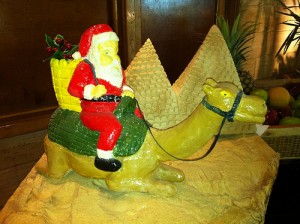 This is Fenzel from Overthinking It, and I felt compelled to address your question.
This is Fenzel from Overthinking It, and I felt compelled to address your question.
“What if” is a pretty broadly based sort of interrogative. It can mean a bunch of different things, depending on context. Generally, it presumes either a condition contrary to fact or a supposition that is understood to be against consensus — the difference between “What if the Hulk had Superman’s flight ability?” (which is not the case, unless you’re talking about Golden Age Superman) and “What if the electromagnetic force and the weak nuclear force were actually two different mathematically equivalent expressions of the same force?” (which seems to be the case, if you give the Standard Model a big heapin’ helpin’ of the benefit of the doubt)
So, let me toss a few questions back to you that maybe get close to a topic you might actually write something interesting about. They are obviously mutually exclusive:
- To what degree is the Christian Tradition of Santa Claus actually the product of Ancient Egyptian thought, art or culture?
- How might the Christian Tradition of Santa Claus be different if it were more directly the product of Ancient Egyptian thought, art or culture (as opposed to the product of what it is)?
- How would the world be different if the Christian Tradition of Santa Claus had been devised by the Ancient Egyptians, and nothing else about Santa Claus was different?
- How would the world be different if the Christian Tradition of Santa Claus had been devised by the Ancient Egyptians, and it was different in ways we might presume it might be if the Egyptians had come up with it more directly?
Twisted Flax, Lasso, Twisted Flax, Lasso, Twisted Flax, Lasso, all with a big rope around it
-Pete
(That roughly transliterates as “HO HO HO.” Very roughly. -PF)
* * *
Have your own ideas about Ancient Egypt and popular culture? About college education? About whether Dragon Ball Z is good for children? Sound off in the comments!
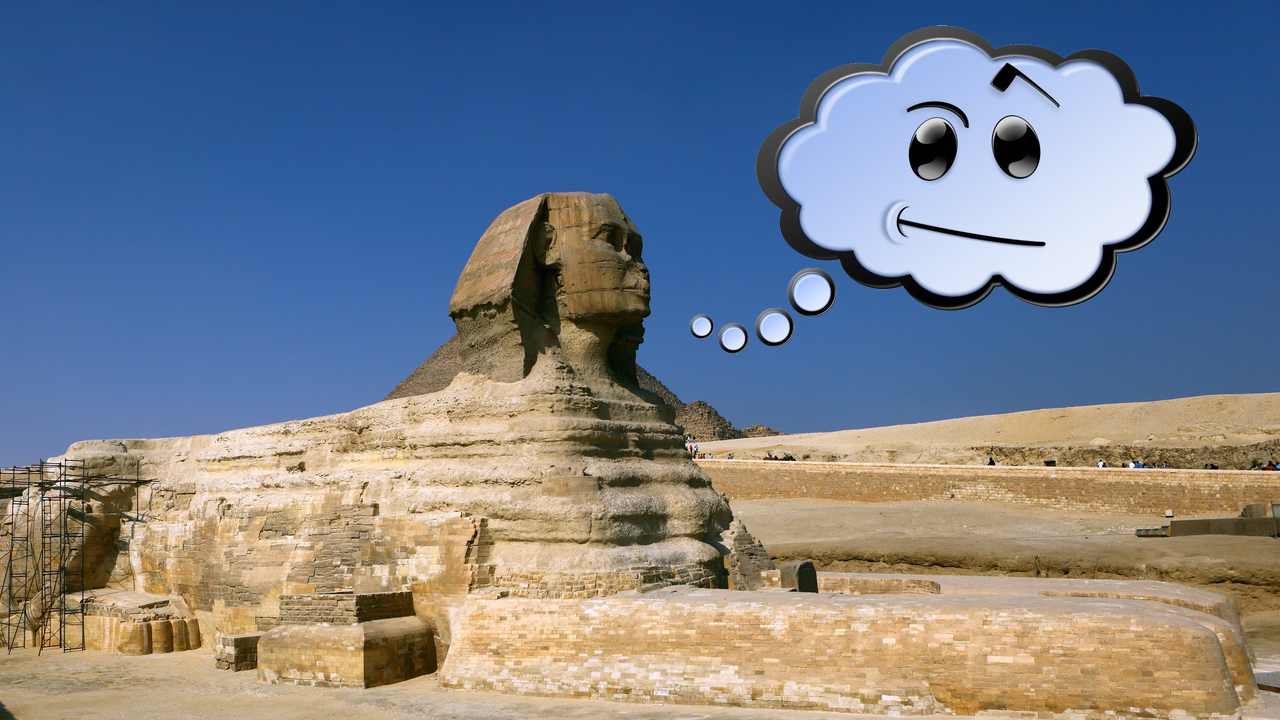

I thoroughly enjoyed this article, and I thought your responses were quite gentle overall.
I would also very much like to see a full article comparing and contrasting the media of stone carving and low-resolution sprites.
As somebody who has, in a professional capacity, been tasked with helping student with essay cultivation and revision, I perhaps got a particular additional enjoyment out of reading this. I was kind of surprised when I saw the first comment say you went easy on them, because your tone would very much be abjectly unacceptable in most, if not all, professional realms.
Which is not to say I think you were too harsh or wrong. There is no need for the coddling of collegiate aged students, especially when they seek out your assessment such as this. You were able to act like some sort of trickster educational adviser, providing insight but also lampooning the lampoonable. Kudos, sir. Kudos.
Also, while I was reading some guy on the internet taking about college students’ essays about Ancient Egypt’s connection to pop culture and Silver Jews’ “Advice to the Graduate” came on my Pandora radio station and for a few, brief, beautiful moments the entire world seemed to make sense. Then, it dissipated, and I was again bathed in the harsh light of our cold, unfeeling reality. Oh well.
This is like an article from 27bslash6.com, only actually educational.
Is it too late to submit my essay about a Laura Mulvey reading of Basic Instinct?
Also is this indicative of American college work? Because the system is very different to the UK.
I think the key question here is, did all of these kids get extra credit just for submitting? Or was actual publication contingent to the extra credit? Does this article serve as documentation that they actually submitted?
…It might *also* count as publication on the site, no?
And one note: this site is dedicated to providing scrutiny where it’s not really useful. Here, as these students’ ersatz prof, you’re applying useful scrutiny to their attempts at the useless kind. They don’t appear to be too good at either, and it seems, based solely on your commentary, that only one appreciated what just happened.
As an American college student, reading these emails made me cringe. It’s a little disheartening that many were so inappropriately poor that they needed mercy more than anything else. It’s pitiful, in the most literal sense. That said, I’d love to see how constraints might have created similarities in 8-bit graphics and Egyptian art.
As an instructor in Computer Information Systems, I’m jealous that I can’t ask my students to write a program that demonstrates loose coupling and strong cohesion and then pitch it as a story idea for Overthinking It. If you find yourself with dozens of pitches having to do with calculating the final cost of a mattress after the calculation of discount rate, delivery fee, and trade-in credit, then you’ll know I finally snapped.
I loved seeing (some of) the creative ideas that these students had. However, I think most of these students missed an opportunity. The term “mystique” relates to the reverence that we hold for the mysterious, particularly the esoteric or occult. By incorporating ancient Egyptian mysticism into contemporary works, the creators of these works are attempting to imbue their work with this sense of awe or reverence. I personally find this hilarious when applied to a work like, “Scooby-Doo! Where’s my Mummy?” On the other hand, I think works like Neil Gaiman’s American Gods really get this right by recontextualizing the esoteric into modern life, and then asking who our Gods are in America (the Media, Internet, and so on), and how they stack up against the ancient Gods. In my opinion, most of these essays for “the mystique of ancient Egypt” would have benefited from a little more focus on the “mystique” part, and a little less focus on the “ancient Egypt” part.